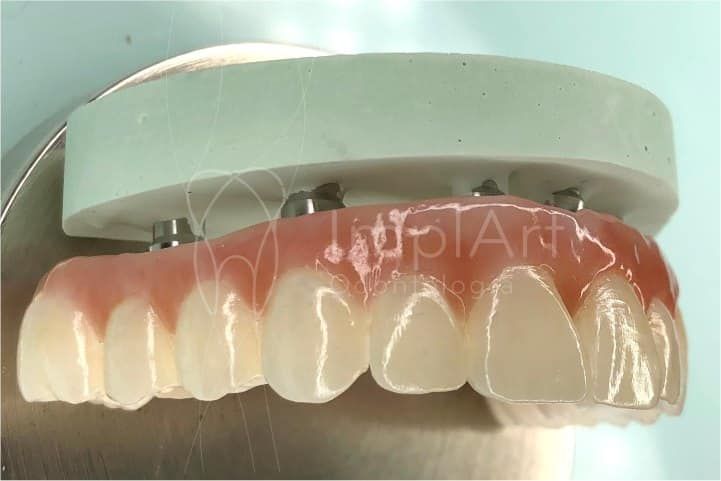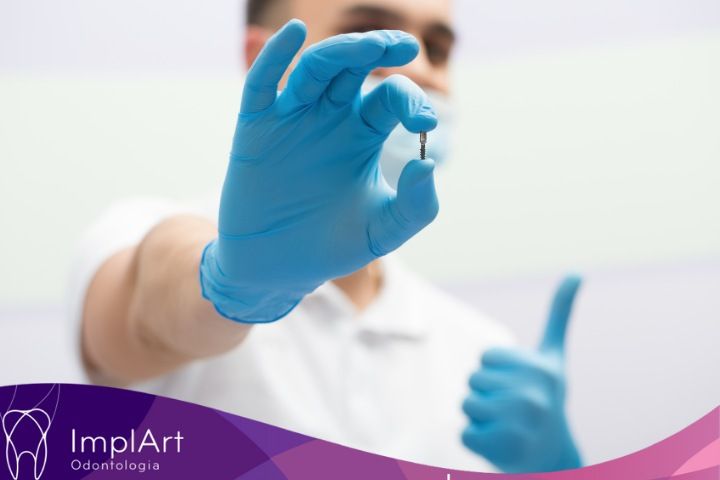Full Arch Dental Implants – All-on-4 – All-on-6 – All-on-X
Full Arch Dental Implants is a Full Mouth Reconstruction treatment, that can be done in the mandible (lower arch) and maxilla (upper arch), although there are important anatomical differences that interfere with the planning of dental implant surgery. Fixed prostheses on dental implants can be made of Zirconia, Pure Zirconia, Porcelain(metal-ceramic), as well as Resin.
This treatment is also known as Fixed Full-Arch Prosthesis or Implant-Supported Denture. This type of implant treatment for all teeth, allows patients to regain their smile and chew.
Dental implant surgery is currently a fairly straightforward operation, carried out in an office or hospital environment, with hospitalization for the patient’s comfort. Implants make it possible to replace missing teeth even in large areas of the arch, including in patients with all their teeth compromised by periodontal disease.
They can also be used in patients with bone loss, who may need bone grafting before or during the installation of the dental implant.
It is important to note that there are currently different types of dental implants, and the most modern ones, cone morse implants, allow for faster healing.
*Read more about how dental implants are done: How are dental implants done? How to get a dental implant ?
Full Arch Dental Implants . Implant-Supported Denture step by step
With regard to the end result, the aim is to obtain fixed dental prostheses that will remain supported on the implants. This will allow the patient to regain their masticatory function and aesthetics.
Of course, as Fixed Full-Arch Prosthesis are screwed onto dental implants, the result is a very efficient dental prosthesis for chewing, as well as excellent aesthetics and comfort.
It is therefore a much better solution than a removable prosthesis, as it provides excellent fixation and stability. In the upper arch, the full arch dental implants treatment has the added advantage of completely uncovering the palate (roof of the mouth), which improves patient comfort.
Unlike removable prostheses (dentures), which cover the roof of the mouth to allow them to be fixed and make it difficult to perceive the taste of food, All-on-X prostheses with implants are thin and occupy only the region of the dentition, leaving the rest of the mouth free, similar to the situation found when there are natural teeth. Currently, the most modern materials are the Zirconia Fixed Full-Arch Prosthesis and the Porcelain Prothesis on a Full Arch DentalTreatment.
*Learn more about dental implants All on Four: 8 common mistakes to avoid when getting dental implants All on Four
Fixed Full-Arch Prosthesis- Full Arch Dental Implants
This type of treatment is usually also called a Fixed Full-Arch Prosthesis ou All-on-4, even All-on-6 and All-on-X.
Visit the total implant photo gallery by clicking here
Read more frequently asked questions about total implants
See also this moving testimonial from a patient who had her whole mouth implanted.
Full Arch Dental Implants .Examinations and planning
After radiographic examinations and a CT scan of the jaws, the dental implant specialist will be able to analyze the ideal planning for the case and thus indicate bone complements such as grafts to better prepare the bone if necessary.
The jaw bone (lower arch) is more rigid and resistant, so dental implants can be installed in most cases. The upper jaw bone, on the other hand, is less dense and delicate and has a more complex anatomy.
Certainly the proximity to the nose, the maxillary sinus cavities and the greater bone loss require further study.




Full Arch Dental Implants With or Without Bone Graft ?
If bone grafting is necessary, don’t be alarmed – it’s very common. Of course, dental grafting for full archa implants is not necessarily complicated, invasive or large. On the contrary, most of the time the bone graft for a full arch implant is simple, small and restricted to the position of the implant.
Less invasive implant surgery: in our clinic we use current concepts of minimally invasive surgery for dental implants, which make the procedure faster and offer greater comfort during the procedure and especially during the healing phase of the dental implant.
Computer-guided implant surgery: this is a type of dental implant surgery offered at our clinic that is planned by computerized scans of the jaws.
For example, computed tomography, in conjunction with a digital mold of the arch (scanner), generates guides for the quick and safe positioning of implants. Click here to learn more about guided surgery for total implants.












Total implant and protocol prosthesis
Full Mouth Reconstruction Prosthesis and other types
Certainly the most common prosthesis for implanting all the teeth in a full arch is the so-called protocol prosthesis. This is a resin prosthesis with a metal reinforcement bar inside.
Over time, however, more modern ways of making complete implant prosthesis have emerged. At the ImplArt Dental Clinic, we offer more technological implant materials, which are completely made on our premises and in our own dental prosthesis laboratory (see more):
- Zirconia prosthesis for total implants (metal-free total implants)
- Fixed dentures with one tooth at a time
- Ceramic protocol – (Porcelain prosthesis)
- Prosthesis bars in lighter metals (Titanium bar)
- Computerized execution (3D printers)
- Rapid dental prostheses (Day Clinic)
If you have any questions, please make an appointment or contact us and make an appointment with our clinical director, Dr. Roberto Markarian, an implant dentist. We will be happy to assist you. The ImplArt Dental Clinic has a modern structure to serve patients and highly specialized professionals.

Text written by DR. ROBERTO MARKARIAN – CRO-SP 73.583
Founder and Director of the ImplArt Dental Clinic – Dr. Roberto’s Linkedin profile
Dr. Roberto Markarian is a reference in dental implants and computerized dental prostheses in Brazil. As well as having more than 10,000 implants installed, he is a researcher who produces knowledge that is published worldwide in renowned scientific journals in the field of dentistry. He is responsible for promoting knowledge and high technology applied to all the treatments offered by the ImplArt Clinic.
- Post-Doctorate in Implant Dentistry – Univ SL Mandic (Campinas-SP) – 2020
- PhD in Implant Dentistry – Doctor of Implant Dentistry, Univ SL Mandic – 2017
- Dr. Roberto Markarian Specialist in Dental Implants at USP (Implant Dentist) – 2008
- Specialist in Prosthodontics (Prosthodontist ) by the CFO – 2006
- Master in Prosthodontics, USP – 2005
- Graduated as a Dental Surgeon from USP (São Paulo) – 2001
- Member of the Clinical Staff of Hospital Alemão Oswaldo Cruz



 Agende sua consulta agora por WhatsApp
Agende sua consulta agora por WhatsApp

